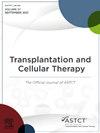非清髓性异基因造血干细胞移植治疗骨髓纤维化。一项来自丹麦东部的基于人群的研究。
IF 3.6
3区 医学
Q2 HEMATOLOGY
引用次数: 0
摘要
背景:骨髓清除调节(MAC)和降低强度调节(RIC)方案均用于同种异体造血干细胞移植(同种异体造血干细胞移植)治疗骨髓纤维化(MF)之前。接受同种异体hct治疗的MF患者的中位年龄正在增加,高非复发死亡率(NRM),特别是MAC,增加了对低强度非清髓性(NMA)方案的使用。在丹麦所有移植中心,NMA被用作治疗MF的同种异体造血干细胞移植前的标准调理方案。目的:描述在同种异体移植前接受NMA调节的高度均质治疗的mf患者群体衍生队列的结果,并确定与移植结果相关的因素。研究设计:该研究是一项回顾性队列研究,研究对象是2007年至2023年在哥本哈根大学Rigshospitalet医院接受allo-HCT前接受NMA治疗的mf患者。结果:2007年至2023年,70例MF患者接受了allo-HCT治疗,其中67例患者接受了氟达拉滨90mg /m2的NMA调理和2-4 Gray的全身照射。这67例患者的中位年龄为61.1岁,22例患者(33%)的Karnofsky表现状态低于90,28例患者(44%)的造血干细胞移植共病指数(HCT-CI)高于2。中位随访时间为3.4年(0.16-15.58年),39例患者(58%)仍然存活。18名患者(27%)复发,在研究期间死亡的28名患者(42%)中,12名(43%)死于复发,16名(57%)死于NRM。中性粒细胞移植、输血不依赖和血小板移植的中位时间分别为21天(11 - 119天)、69天(0 - 470天)和17天(0 - 308天),其中13例(19.7%)患者发现原发性移植失败。1年、3年和5年后的总生存率(OS)分别为77%、68%;61%,而NRM是15%,15%和21%。1年后的累积复发率为24%,3年后为28%,5年后为28%。多变量分析显示男性(HR= 5.43, p)。结论:低剂量TBI和氟达拉滨治疗MF前的NMA调节是可行的。患者的1年NRM较低,但1年CIR相对较高。对于年轻和健康的患者,采用更密集的RIC治疗方案可以考虑降低早期复发率,而不增加NRM。在生存分析中,供患关系、患者合并症负担和患者性别与OS独立相关。本文章由计算机程序翻译,如有差异,请以英文原文为准。
Non-myeloablative Allogeneic Hematopoietic Stem Cell Transplantation for Myelofibrosis. A Population-Based Study from Eastern Denmark
Myeloablative conditioning (MAC) and reduced intensity conditioning (RIC) regimens are both used before allogeneic hematopoietic stem cell transplantation (allo-HCT) for myelofibrosis (MF). The median age of patients with MF treated with allo-HCT is increasing and a high non-relapse mortality (NRM), especially to MAC, has increased utilization of lesser intense non-myeloablative (NMA) regimens. The NMA regimen is used as the standard conditioning regimen before allo-HCT for MF at all transplantation centers in Denmark. We describe the outcomes of a highly homogenously treated, population-derived cohort of patients with MF who received NMA conditioning prior to allo-HCT and identify factors associated to transplantation outcomes. The study is a retrospective cohort study of patients with MF treated with an NMA regimen prior to allo-HCT at Copenhagen University Hospital, Rigshospitalet from 2007 to 2023. Of 70 patients with MF who were treated with allo-HCT for MF from 2007 to 2023, 67 patients received NMA conditioning with fludarabine 90 mg/m2 and total body irradiation of 2 to 4 Gray. These 67 patients had a median age of 61.1 years, 22 patients (33%) had a Karnofsky performance status below 90, and 28 patients (44%) had a hematopoietic stem cell transplantation comorbidity index (HCT-CI) above 2. With a median follow-up time of 3.4 years (range, 0.16–15.58 years), 39 patients (58%) were still alive. Eighteen patients (27%) relapsed and of the 28 patients (42%) who died during the study period, 12 (43%) died from relapse and 16 (57%) from NRM. Median time to neutrophil engraftment, transfusion independency, and platelet engraftment was 21 days (range, 11-119 days), 96 days (range, 0-470 days) and 17 days (range, 0-308 days), respectively, with primary graft failure identified in 13 patients (19.7%). Overall survival (OS) after 1, 3, and 5 years was 77%, 68%, and 61%, respectively, whereas the NRM was 15%, 15%, and 21%, respectively. The cumulative incidence of relapse (CIR) was 24% after 1 year, 28% after 3 years, and 28% after 5 years. Multivariable analysis showed that male sex (hazard ratio (HR) = 5.43, P < .001), graft from unrelated donor (HR = 3.58, P = .018) and HCT-CI above 2 (HR = 2.5, P = .025) remained associated to OS, whereas for progression-free survival, only NRAS mutations remained as an independent factor (HR = 5.88, P = .013). Both male sex (HR = 8.41, P = .037) and graft from unrelated donor (HR = 3.15, P = .043) were associated to NRM in multivariable analysis. Our analysis shows that NMA conditioning in the form of low dose total body irradiation and fludarabine before allo-HCT for MF is feasible. Patients show low 1-year NRM but a relatively high 1-year CIR. Differentiated conditioning with more intensive RIC regiments for younger and fit patients could be considered to reduce the early relapse rate without increasing NRM. In survival analysis, donor-patient relation, patient comorbidity burden and patient sex were independently associated to OS.
求助全文
通过发布文献求助,成功后即可免费获取论文全文。
去求助
来源期刊

Transplantation and Cellular Therapy
Medicine-Hematology
CiteScore
7.00
自引率
15.60%
发文量
1061
审稿时长
51 days
 求助内容:
求助内容: 应助结果提醒方式:
应助结果提醒方式:


